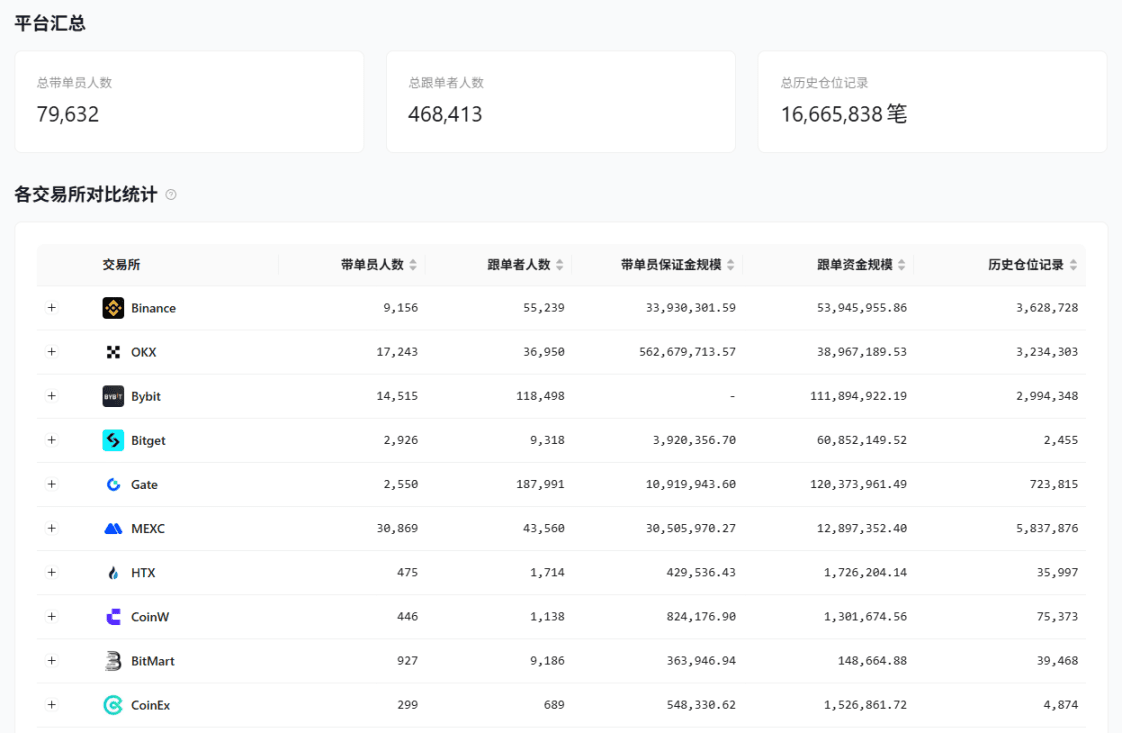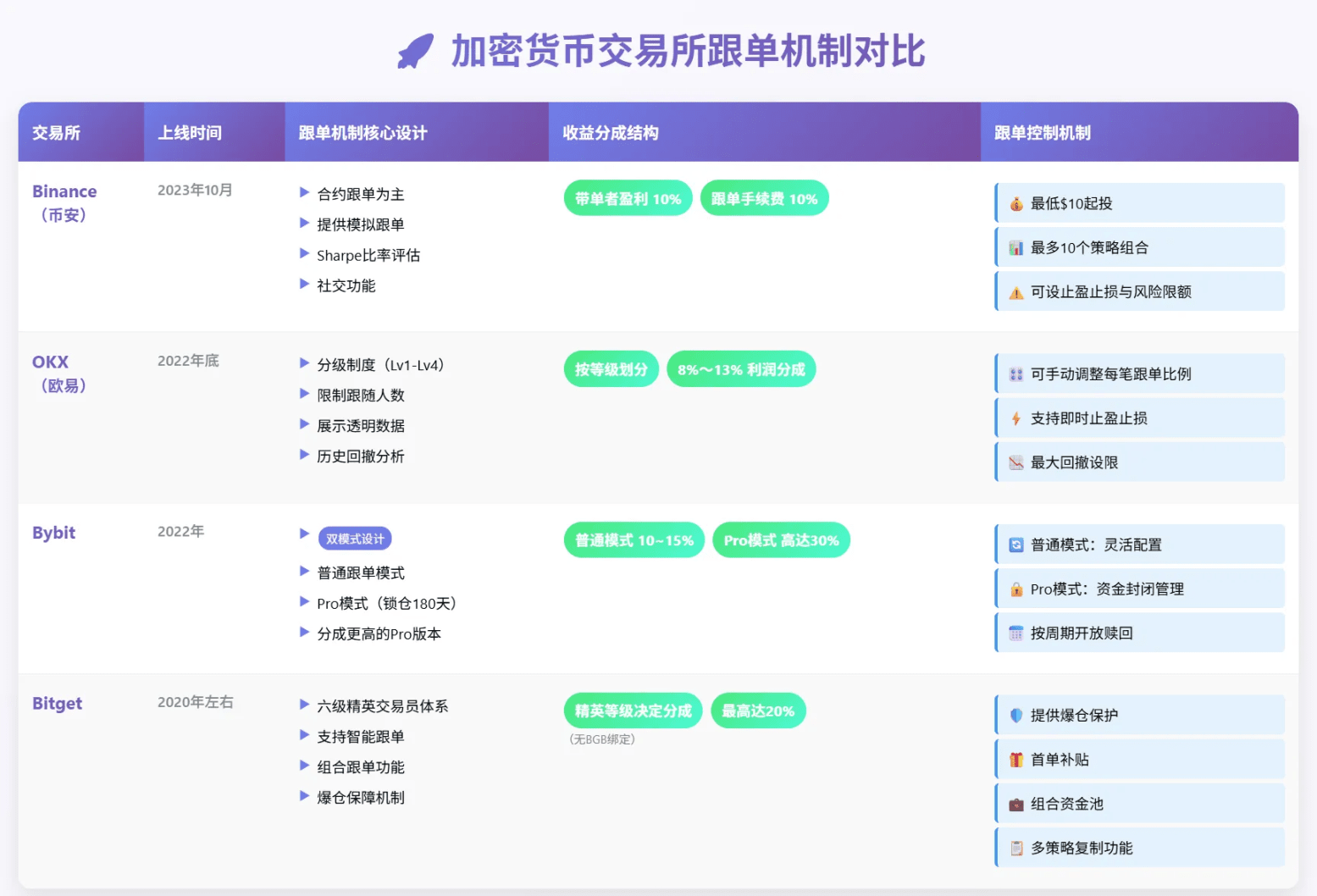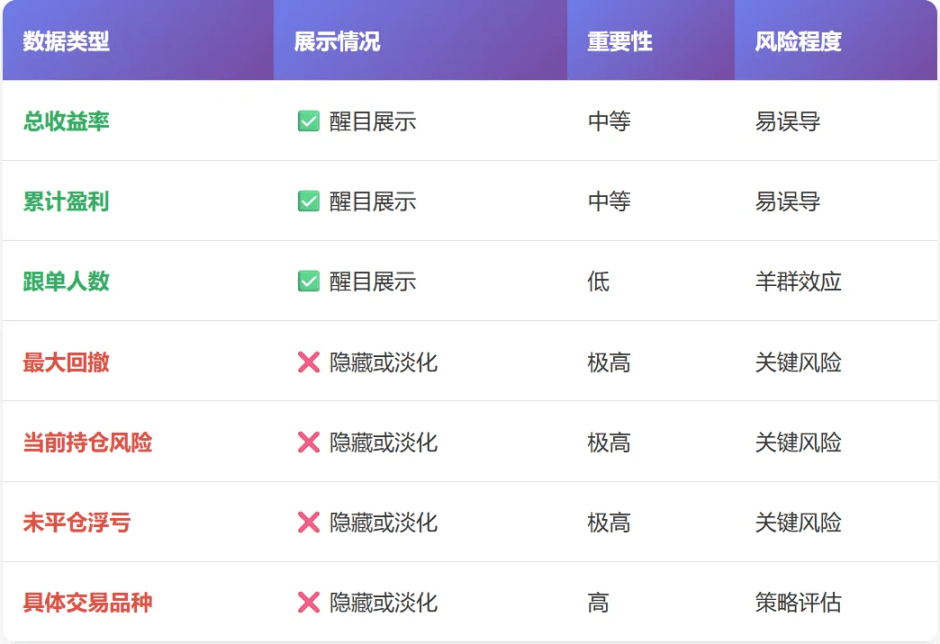Introduction
After we started analyzing copy trading data, we received a private message from a regular copy trader who was attracted by short-term high ROI but left disheartened after significant drawdowns; feeling like a blindfolded gambler in the face of opaque data; deeply questioning the fairness of the rankings.
This letter serves as a wake-up call, making us realize that behind the cold trading data lies the expectations and disappointments of countless real users. We have decided to combine this emotional voice with our professional data analysis capabilities on the copy trading platform to present a deep and comprehensive industry analysis for all platforms, signal providers, and copy trading users. This is both a response to that letter and a practice of our belief that 'data creates trust.'

Data Source: Professional Copy Trading Analysis Platform (https://insights.wolfdao.com/) Overview of Exchange Copy Trading
Preface
Copy trading, as a crucial part of the crypto world, has exploded in growth, confirming the huge market demand. Although the existing ranking mechanisms and traffic logic face many challenges, this does not mean the copy trading market is a 'dead end'. On the contrary, we observe that leading platforms are actively making improvements, such as introducing the Sharpe Ratio and strengthening the disclosure of drawdown data, marking the industry's progress from barbaric growth towards a healthier and more sustainable direction.
As an expert deeply engaged in the market, we firmly believe that the copy trading market has huge development potential. Its future lies in how it evolves from a mere 'traffic aggregator' into a 'value co-creator', truly achieving long-term win-win outcomes for exchanges, traders, and copy traders. This report will start from this core idea, analyze the current shortcomings of the platforms, and propose specific improvement suggestions.
The core pain point of the current copy trading market: the 'prisoner's dilemma' of the three parties.
Although the copy trading market appears prosperous on the surface, its underlying mechanisms are pushing all three parties into a 'prisoner's dilemma':
For exchanges: The significant commission income from high-risk, high-frequency trading in the short term is substantial, but in the long run, the massive losses of copy trading users will damage the platform's reputation, leading to user attrition and ultimately affecting sustainable development.
For traders: The existing ROI-centric ranking mechanism forces traders to adopt aggressive strategies to make the list, which violates the principles of prudent trading and exposes their accounts to significant liquidation risks. They might gain temporary glory from one risky move but could also face disgrace from a single mistake.
For copy traders: They are attracted by high returns but struggle to see the real risks behind them. The severe information asymmetry reduces them to 'passive investors', bearing the trial-and-error costs of traders without receiving complete risk protection.
1. The 'incentive distortion' effect of mainstream exchange copy trading mechanisms.
The mechanism designs of different platforms are not accidental; they are the embodiment of the platforms' commercial strategies and directly lead to the incentive distortion of trader behavior.

Data Source: WolfDAO Community (https://t.me/wolfinsights) member collected and organized.
In-depth Interpretation of Platform Strategies and Behavioral Attribution
Binance:
Advantages: By introducing the Sharpe Ratio, a quantitative measure of risk-adjusted returns, Binance attempts to balance returns and risks to a certain extent, advocating for prudent trading. The lower entry threshold for copy trading and a strong user base provide fertile ground for the early expansion of the copy trading ecosystem.
Potential Risks: The early stage of the product lifecycle determines that its content ecosystem is not yet fully matured. In this phase of 'new user influx and incomplete content', users tend to rely on short-term, intuitive high-yield data as decision-making criteria, potentially overlooking the huge risks lurking behind.
OKX:
Advantages: Its tiered navigator system and emphasis on historical drawdowns represent its proactive exploration in risk control. By limiting the influence range of novice traders, the platform attempts to filter out more professional signal providers from the source.
Potential Risks: 'Selective transparency' remains a common issue in the industry. The historical drawdowns emphasized by platforms may only cover closed positions and not disclose unrealized losses. Furthermore, when the incentive mechanisms fail to attract traders pursuing 'content value' rather than short-term ROI, the 'star effect' of their rankings may be surpassed by other platforms, leading users to flow back to those better-packaged 'high-yield' traders.
Bybit:
Advantages: Through the Copy Trading Pro model (180-day lock-up) and up to 30% revenue sharing, Bybit explicitly aims to attract high-net-worth and strategically mature top traders. This is a 'premium' strategy attempting to build a high-end copy trading ecosystem.
Potential Risks: High thresholds exclude ordinary users, and the characteristics of limited liquidity make it more suitable for long-term investors. Furthermore, some marketing activities, such as 'human vs. bot copy trading competitions', may enhance community engagement but could also inadvertently strengthen users' blind worship of 'trading myths' rather than rationally assessing risks.
Bitget:
Advantages: As a 'pioneer' in the copy trading field, its comprehensive multi-tier elite trader system and high incentive structure have matured its ecosystem, creating a powerful network effect.
Potential Risks: This efficient 'incentive mechanism' may also become a hidden force driving traders to take excessive risks. To achieve a higher elite level and gain more revenue sharing and exposure, traders may be 'kidnapped' by the incentive mechanism, adopting more aggressive game strategies. The 'liquidation protection' and other 'benefits' they provide resemble marketing strategies aimed at lowering users' psychological thresholds rather than genuine risk hedging.
2. The 'traffic rent-seeking' logic of platform ranking mechanisms.
The ranking of copy trading platforms is not a neutral strength ranking but a 'traffic rent-seeking' tool shaped by the commercial interests of the platform.
First Layer of Rent-Seeking: ROI supremacy in a 'winner-takes-all' game.
Most platforms default to sorting by ROI or cumulative profit, pushing 'profit-oriented' signal providers who double profits in a short time to the top.
Commercial Logic: Platforms understand well that 'astronomical figures' are the strongest catalyst for attracting users' attention and stimulating copy trading desires. By highlighting ROI, platforms can maximize the use of users' 'wealth effect' psychology, achieving explosive growth in trading volume and maximizing commission income in the short term.
Behavior Attribution: This mechanism pushes traders into a 'winner-takes-all' game. To compete for the top, traders are induced to engage in high-leverage, heavy-position bets on small coins, even using multiple accounts to rank up and display the best-performing accounts. This behavior is unsustainable yet perfectly aligns with the platform's short-term commercial needs.
Second Layer of Rent-Seeking: The 'selective disclosure' and 'data resetting' of historical performance.

Data Source: WolfDAO Community (https://t.me/wolfinsights) member collected and organized.
The rankings depend on the historical data provided by signal providers, but this data may be carefully packaged or even 'legally' erased.
Data Manipulation Methods:
Multi-account Filtering: Operating multiple accounts simultaneously, only displaying the one with the best performance.
Selective Time Window: Calculating returns starting when the market rises sharply, creating an illusion of excellent performance.
Account Reset: After experiencing significant losses, close the account and restart as a 'newcomer', erasing all records of failure. Some platforms allow signal providers to pause or close copy trading services, facilitating this 'data whitening'.
Periodic Harvesting: This mechanism allows some signal providers to conduct 'periodic harvesting': when account performance is poor, they can 'exit', wait for market opportunities to restart, and cover past failures with new 'brilliant' performances. This forces copy traders to bear all the trial-and-error costs of signal providers without enjoying complete risk disclosure.
Third Layer of Rent-Seeking: Platform Interest-Driven 'Algorithm Bias'
In addition to the ranking algorithm, platforms also influence the rankings and exposure of signal providers through various mechanisms 'behind the scenes'.
Three Major Bias Mechanisms:
Volume-Oriented: High-frequency trading signal providers contribute more to the platform's commission, thus may gain invisible bonuses.
User Acquisition Reward Mechanism: If signal providers can bring in a large number of new users through social media, the platform will provide more traffic support, creating a 'head effect.'
Brand Building Needs: Signal providers with a healthy image and cooperative publicity are more likely to make the list and become the platform's spokesperson.
The result of these mechanisms is that 'influencer' traders with strong marketing abilities may gain more traffic than 'practical' traders with strong trading skills. The ranking list is not only a display of strength but also a marketing tool and traffic distribution hub for the platform.
Second Layer of Rent-Seeking: The 'blind spots' and 'black boxes' of information disclosure.

Data Source: WolfDAO Community (https://t.me/wolfinsights) member collected and organized.
Information asymmetry is the core risk of copy trading. Platforms usually selectively display data, hiding key risk indicators.
Information Asymmetry: Platforms typically only display positive data like total returns, cumulative profits, and win rates, while key information that truly reflects risk, such as maximum drawdown, current position risks, and unrealized losses, is deliberately ignored.
The black box of trading details: Trading details (such as specific trading pairs, positions) are often hidden, making it impossible for users to judge whether the signal provider relies on a prudent strategy or sheer luck for profits. This opacity creates space for fraud and short-term ranking manipulation.
Conclusion: Trust is the core asset of the copy trading market.
The future of the copy trading market lies not in how many 'get rich overnight' myths are born, but in whether a fair, transparent, and trustworthy ecosystem can be established. We have already seen that some platforms are working towards this direction.
Every data improvement and algorithm adjustment made by the platform represents more consideration for user interests. When exchanges are willing to provide traders with a stage free from 'ranking manipulation', when traders can gain recognition through prudent rather than aggressive strategies, and when copy traders can obtain real and comprehensive information, the market can truly evolve from a 'traffic rent-seeking machine' into a 'value co-creator.'
This is not only an evolution of the copy trading market but also a necessary path for the maturation of the crypto financial ecosystem.
If you have unique insights on how to select quality signal providers, if you have encountered confusion in your copy trading journey, or if you have any thoughts on the future development of copy trading platforms and trading, we sincerely invite you to join our discussion. Join our Telegram group to share experiences and exchange ideas with more like-minded friends, and contribute to building a trustworthy crypto trading ecosystem.
Data Update Note: The above report data is compiled by WolfDAO. If you have any questions, please contact us for updates.
Written by: WolfDAO (X: @10xWolfDAO)
